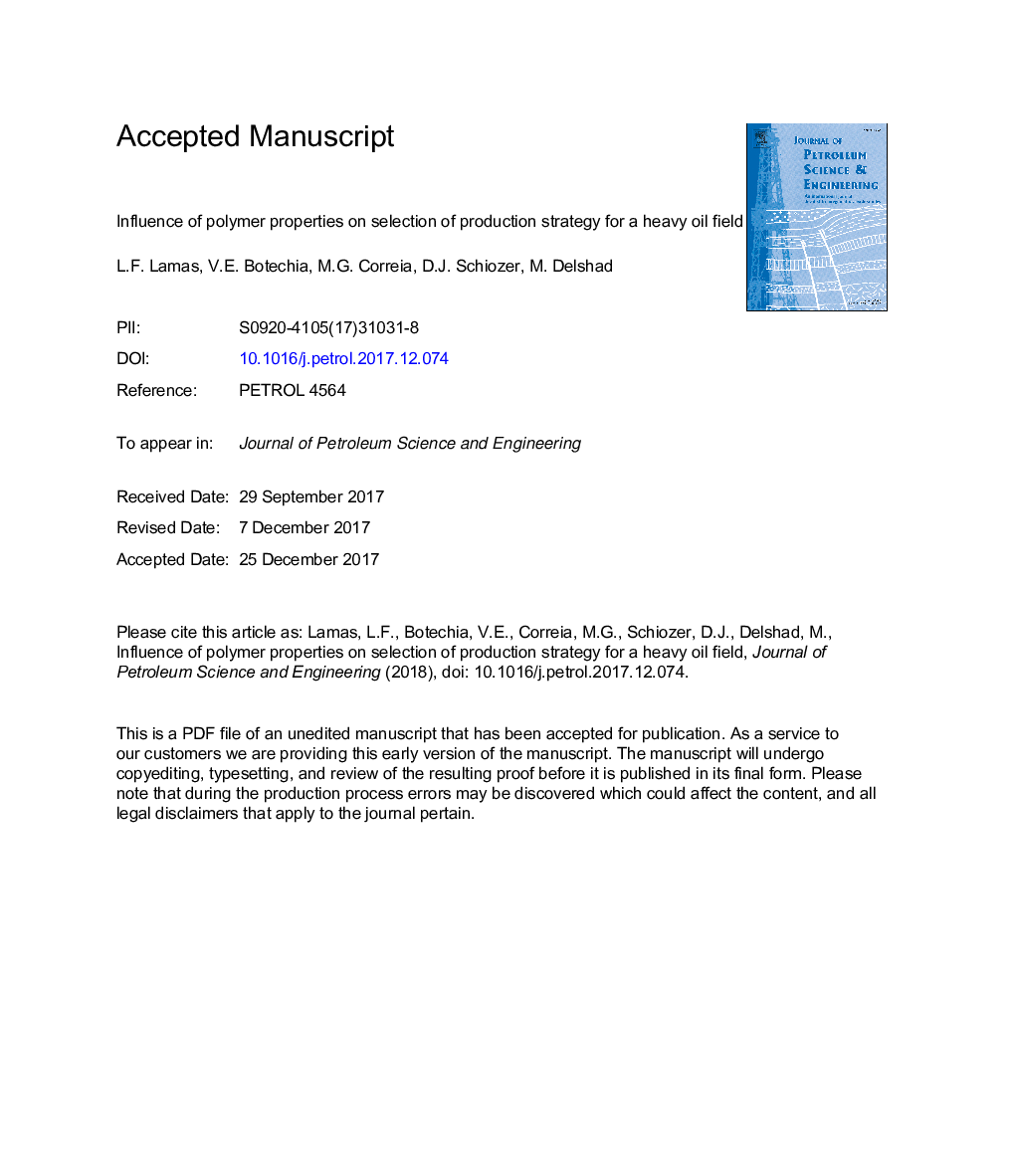| کد مقاله | کد نشریه | سال انتشار | مقاله انگلیسی | نسخه تمام متن |
|---|---|---|---|---|
| 8125269 | 1522778 | 2018 | 21 صفحه PDF | دانلود رایگان |
عنوان انگلیسی مقاله ISI
Influence of polymer properties on selection of production strategy for a heavy oil field
ترجمه فارسی عنوان
تاثیر خواص پلیمری بر انتخاب استراتژی تولید میدان نفتی سنگین
دانلود مقاله + سفارش ترجمه
دانلود مقاله ISI انگلیسی
رایگان برای ایرانیان
کلمات کلیدی
سیل پلیمری، انتخاب استراتژی تولید، شبیه سازی عددی مخزن، مهندسی مخزن، بازیابی روغن شیمیایی، مدیریت مخزن،
موضوعات مرتبط
مهندسی و علوم پایه
علوم زمین و سیارات
زمین شناسی اقتصادی
چکیده انگلیسی
Polymer flooding is an enhanced oil recovery method (EOR) where water-soluble polymer is added to the injection brine. This increases brine viscosity and reduces water mobility, aiming to increase volumetric sweep and thus oil recovery. Selection and development of a production strategy for oil field is a complex task. Polymer properties bring additional complexity to this process and it is important that each of them is properly treated and considered. This paper discusses the selection of production strategy considering different approaches: (1) water flooding, (2) ideal polymer (only viscosifying effect of polymer) and (3) polymer flooding, including separately four of the most influencing polymer properties i.e. retention, viscoelasticity, salinity and degradation. The analysis is extended to a probabilistic point of view, where scenarios were generated combining geological and polymer uncertainties. Selected production strategies are compared to quantify the impact of each property on field indicators. Comparisons were made in terms of net present value (NPV), produced oil, injected and produced water, oil recovery factor and polymer mass. Two different situations were considered: (1) to optimize considering each property since beginning (design + control variables, meaning development, and management stages) and (2) considering design variables (development stage) for ideal polymer, optimizing only control variables (management stage) for each property. The methodology is applied to a synthetic field, based on characteristics of an offshore field with high permeability (â¼1 000 mD) and containing heavy and viscous oil (â¼100 cP, 14° API). Ranking the properties according to overall impact on the project NPV, it was found the impact of each variable in a descending order: degradation, salinity, viscoelasticity, and retention. Water and ideal polymer strategies limit indicators results, giving an idea of the performance of strategies. Considering the key polymer properties from the beginning of optimization process resulted in similar values in terms of NPV when compared with strategies that considered ideal polymer in the selection of project variables. Risk curves show that conclusions can be extended to a probabilistic point of view. The results allow a comprehensive understanding of the influence of each polymer property on selection of production strategy considering uncertainties. The results also show that it is possible to select a good strategy using Ideal polymer model. Finally, results show that strategies selected for water and for ideal polymer model act as lower and upper limits of performance for the field, giving valuable information to the decision maker, even before accurate data about polymer is available.
ناشر
Database: Elsevier - ScienceDirect (ساینس دایرکت)
Journal: Journal of Petroleum Science and Engineering - Volume 163, April 2018, Pages 110-118
Journal: Journal of Petroleum Science and Engineering - Volume 163, April 2018, Pages 110-118
نویسندگان
LuÃs Fernando Lamas, VinÃcius Eduardo Botechia, Manuel Gomes Correia, Denis José Schiozer, Mojdeh Delshad,
